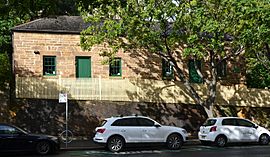Glover cottages facts for kids
Quick facts for kids Glover cottages |
|
|---|---|

Glover cottages as seen from Kent Street
|
|
| Alternative names | The Ark |
| General information | |
| Status | Complete |
| Type |
|
| Architectural style | Colonial Georgian |
| Location | 124-134 Kent Street, Millers Point, New South Wales |
| Country | Australia |
| Coordinates | 33°51′48″S 151°12′10″E / 33.8632633215986°S 151.202883215236°E |
| Current tenants | Australian Institute of International Affairs |
| Construction started | 1820 |
| Completed | 1838 |
| Client |
|
| Owner | Government of New South Wales |
| Landlord | via State Property Authority |
| Design and construction | |
| Main contractor | James Pashley |
| Official name | Glover Cottages |
| Type | Historic |
| Designated | 21 March 1978 |
| Reference no. | 2164 |
|
Invalid designation
|
|
| Official name | Terrace Group "Glover Cottages" Including Interiors |
| Type | Built (local register) |
| Criteria | a., b., c., d., e., f., g. |
| Designated | 14 December 2012 |
| Reference no. | I925 |
The Glover Cottages are a pair of historic homes in Millers Point, a suburb of Sydney, Australia. These two homes, called semi-detached cottages, share a wall. They were built a long time ago, between 1820 and 1838. Their style is known as Colonial Georgian. Today, they are used as offices.
Contents
What are the Glover Cottages?
The Glover Cottages are built on a special rock shelf. This shelf might have been made by people digging for stone between 1810 and 1830. A man named Edward Ewen, who made barrels for a living, built the first cottages here.
Who owned the cottages?
Edward Ewen later sold the property to Thomas Glover. Thomas Glover was a publican, meaning he owned a pub. His main business was in The Rocks. Thomas Glover saw the cottages as a way to earn money. He fixed them up and even built two more houses on the land.
Thomas Glover passed away in 1836. After some legal steps, the property went to his son, James Glover, in 1840. The cottages stayed with the Glover family for many years, until 1900. They were used as homes and also rented out to make money. Over time, the cottages became known as The Ark.
What happened after 1900?
Around 1900, there was a serious outbreak of bubonic plague in Sydney. The government took over many properties, including the Glover Cottages. However, it turned out the cottages were not needed for the plague efforts.
In 1979, the cottages were fixed up again. They were changed from homes to offices. A nice courtyard was also added at the back.
Why are the Glover Cottages important?
The Glover Cottages are very important because of their history. They are a rare example of homes built before the land was officially given out. They also show how buildings looked in colonial towns in the 1820s. They are among the few small homes from that time that are still standing today.
Being listed as heritage
On December 14, 2012, the cottages were added to the New South Wales Heritage Database. This means they are officially recognized as important historical buildings. The listing says the cottages are special because:
- They are a rare example of a single-story stone cottage from the 1820s in Sydney.
- They show how Millers Point developed before streets were formally planned.
- They show how land was divided before official ownership papers were given.
- They represent buildings that survived after the plague clean-ups.
- They show the role of the Sydney Harbour Trust (and later the MSB) in providing homes for workers.
The cottages were also listed on the (now closed) Register of the National Estate on March 21, 1978.
Images for kids



